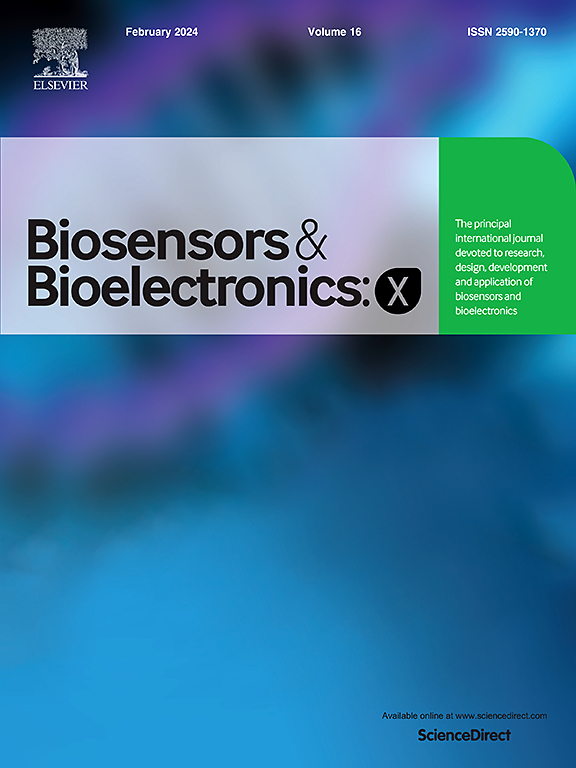Development of vitex-derived polymer nanofibers using electrochemical sensors for the treatment of polycystic ovarian syndrome in rats as an animal model
IF 10.61
Q3 Biochemistry, Genetics and Molecular Biology
引用次数: 0
Abstract
Background and objectives
Nanofibers have a high specific surface area and small pores, which increases the possibility of drug uptake. In this study, chasteberry-containing nanofibers were prepared by electrospinning to investigate their potential for polycystic follicles after induction of polycystic ovarian syndrome (PCOS).
Materials and methods
Chasteberry-containing nanofibers were identified using Fourier-transform infrared spectroscopy (FTIR), Field Emission Scanning Electron Microscopy (FESEM), and thermal gravimetric analysis (TGA) tests, as well as drug release and antibacterial tests. In this study, 42 Sprague-Dawley rats with regular menstrual cycles were divided into five groups: control group (healthy rats), polycarbonate (PC) group (treated with 1 mg/kg letrozole for 28 days to induce PCOS syndrome), and Poly terephthalate (PT) group (treated with PCOS for 30 days). Chasteberry was included at 1, 2, 4 wt%. To induce PCOS, the polyterephthalate (PT) and polycarbonate (PC) groups were administered 1 mg/kg letrozole by oral gavage for 28 days. The polyterephthalate (PT) group was treated with different doses of chasteberry-containing nanofibers (1, 2, 4 wt%).
Results
The results showed that the drug was well incorporated into the fibers and released slowly and sustainedly from the nanofibers for 30 days. Ex vivo results showed that by taking letrozole, the polycarbonate (PC) group had larger cystic follicles with a very thin granulosa layer than the control group. This is the cause of ovarian anovulation or oligo-ovulation and induction of polycystic ovarian syndrome. In the polyterephthalate (PT) group, which was administered nanofibers containing chasteberry nanomedicine subcutaneously, the number of cystic follicles decreased and the number of various follicles indicating ovulation increased in these groups.
Conclusion
Subcutaneous administration of Vitex nanofibers at a dose of 4 wt% can improve polycystic ovarian syndrome by decreasing cystic follicles and increasing the number of various follicles and corpora lutea.
利用电化学传感器制备紫荆衍生聚合物纳米纤维治疗大鼠多囊卵巢综合征
背景与目的纳米纤维具有高比表面积和小孔隙,这增加了药物吸收的可能性。本研究采用静电纺丝法制备了含有蔓越莓的纳米纤维,研究了其在诱导多囊卵巢综合征(PCOS)后对多囊卵巢的影响。材料与方法采用傅里叶变换红外光谱(FTIR)、场发射扫描电镜(FESEM)、热重分析(TGA)以及药物释放和抗菌试验对含紫菀子纳米纤维进行鉴定。本研究将42只月经周期正常的Sprague-Dawley大鼠分为5组:对照组(健康大鼠)、聚碳酸酯(PC)组(给予1 mg/kg来曲唑28 d诱导PCOS综合征)、聚对苯二甲酸酯(PT)组(给予PCOS 30 d)。在1、2、4 wt%时加入蔓越莓。为诱导PCOS,聚对苯二甲酸酯(PT)组和聚碳酸酯(PC)组小鼠灌胃来曲唑1 mg/kg,持续28 d。聚对苯二甲酸乙二醇酯(PT)组用不同剂量的含有蔓越莓的纳米纤维(1,2,4 wt%)处理。结果药物与纳米纤维结合较好,缓释时间为30 d。体外实验结果显示,服用来曲唑后,聚碳酸酯(PC)组的囊泡比对照组大,颗粒层极薄。这是卵巢无排卵或少排卵的原因,诱发多囊卵巢综合征。在聚对苯二甲酸酯(PT)组中,皮下注射含有蔓越莓纳米药物的纳米纤维,这些组中囊泡数量减少,各种卵泡数量增加。结论紫荆纳米纤维皮下注射剂量为4wt %,可通过减少囊泡、增加各种卵泡和黄体数量来改善多囊卵巢综合征。
本文章由计算机程序翻译,如有差异,请以英文原文为准。
求助全文
约1分钟内获得全文
求助全文
来源期刊

Biosensors and Bioelectronics: X
Biochemistry, Genetics and Molecular Biology-Biophysics
CiteScore
4.60
自引率
0.00%
发文量
166
审稿时长
54 days
期刊介绍:
Biosensors and Bioelectronics: X, an open-access companion journal of Biosensors and Bioelectronics, boasts a 2020 Impact Factor of 10.61 (Journal Citation Reports, Clarivate Analytics 2021). Offering authors the opportunity to share their innovative work freely and globally, Biosensors and Bioelectronics: X aims to be a timely and permanent source of information. The journal publishes original research papers, review articles, communications, editorial highlights, perspectives, opinions, and commentaries at the intersection of technological advancements and high-impact applications. Manuscripts submitted to Biosensors and Bioelectronics: X are assessed based on originality and innovation in technology development or applications, aligning with the journal's goal to cater to a broad audience interested in this dynamic field.
 求助内容:
求助内容: 应助结果提醒方式:
应助结果提醒方式:


